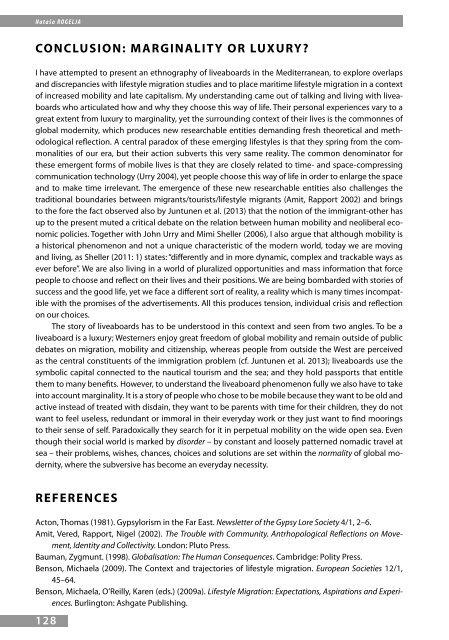Nataša ROGELJACONCLUSION: MARGINALITY OR LUXURY?I have attempted to present an ethnography of liveaboards <strong>in</strong> the Mediterranean, to explore overlapsand discrepancies with lifestyle migration studies and to place maritime lifestyle migration <strong>in</strong> a contextof <strong>in</strong>creased mobility and late capitalism. My understand<strong>in</strong>g came out of talk<strong>in</strong>g and liv<strong>in</strong>g with liveaboardswho articulated how and why they choose this way of life. Their personal experiences vary to agreat extent from luxury to marg<strong>in</strong>ality, yet the surround<strong>in</strong>g context of their lives is the commonnes ofglobal modernity, which produces new researchable entities demand<strong>in</strong>g fresh theoretical and methodologicalreflection. A central paradox of these emerg<strong>in</strong>g lifestyles is that they spr<strong>in</strong>g from the commonalitiesof our era, but their action subverts this very same reality. The common denom<strong>in</strong>ator forthese emergent forms of mobile lives is that they are closely related to time- and space-compress<strong>in</strong>gcommunication technology (Urry 2004), yet people choose this way of life <strong>in</strong> order to enlarge the spaceand to make time irrelevant. The emergence of these new researchable entities also challenges thetraditional boundaries between migrants/tourists/lifestyle migrants (Amit, Rapport 2002) and br<strong>in</strong>gsto the fore the fact observed also by Juntunen et al. (2013) that the notion of the immigrant-other hasup to the present muted a critical debate on the relation between human mobility and neoliberal economicpolicies. Together with John Urry and Mimi Sheller (2006), I also argue that although mobility isa historical phenomenon and not a unique characteristic of the modern world, today we are mov<strong>in</strong>gand liv<strong>in</strong>g, as Sheller (2011: 1) states: “differently and <strong>in</strong> more dynamic, complex and trackable ways asever before”. We are also liv<strong>in</strong>g <strong>in</strong> a world of pluralized opportunities and mass <strong>in</strong>formation that forcepeople to choose and reflect on their lives and their positions. We are be<strong>in</strong>g bombarded with stories ofsuccess and the good life, yet we face a different sort of reality, a reality which is many times <strong>in</strong>compatiblewith the promises of the advertisements. All this produces tension, <strong>in</strong>dividual crisis and reflectionon our choices.The story of liveaboards has to be understood <strong>in</strong> this context and seen from two angles. To be aliveaboard is a luxury; Westerners enjoy great freedom of global mobility and rema<strong>in</strong> outside of publicdebates on migration, mobility and citizenship, whereas people from outside the West are perceivedas the central constituents of the immigration problem (cf. Juntunen et al. 2013); liveaboards use thesymbolic capital connected to the nautical tourism and the sea; and they hold passports that entitlethem to many benefits. However, to understand the liveaboard phenomenon fully we also have to take<strong>in</strong>to account marg<strong>in</strong>ality. It is a story of people who chose to be mobile because they want to be old andactive <strong>in</strong>stead of treated with disda<strong>in</strong>, they want to be parents with time for their children, they do notwant to feel useless, redundant or immoral <strong>in</strong> their everyday work or they just want to f<strong>in</strong>d moor<strong>in</strong>gsto their sense of self. Paradoxically they search for it <strong>in</strong> perpetual mobility on the wide open sea. Eventhough their social world is marked by disorder – by constant and loosely patterned nomadic travel atsea – their problems, wishes, chances, choices and solutions are set with<strong>in</strong> the normality of global modernity,where the subversive has become an everyday necessity.REFERENCESActon, Thomas (1981). Gypsylorism <strong>in</strong> the Far East. Newsletter of the Gypsy Lore Society 4/1, 2–6.Amit, Vered, Rapport, Nigel (2002). The Trouble with Community. Antrhopological Reflections on Movement,Identity and Collectivity. London: Pluto Press.Bauman, Zygmunt. (1998). Globalisation: The Human Consequences. Cambridge: Polity Press.Benson, Michaela (2009). The Context and trajectories of lifestyle migration. European Societies 12/1,45–64.Benson, Michaela, O’Reilly, Karen (eds.) (2009a). Lifestyle Migration: Expectations, Aspirations and Experiences.Burl<strong>in</strong>gton: Ashgate Publish<strong>in</strong>g.128
Liveaboards <strong>in</strong> the Mediterranean: Luxury or Marg<strong>in</strong>ality? – Ethnographic Reflections on Maritime Lifestyle MigrationBenson, Michaela, O’Reilly, Karen (2009b). Migration and the search for a better way of life: a criticalexploration of lifestyle migration. The Sociological Review 57/4, 608–625.Berland, Joseph C., Salo, Matt T. (1986). Peripatetic Communities: An Introduction. Peripatetic peoples.Nomadic Peoples. Special Issue 21/22.Bourdieu, Pierre (1984). Dist<strong>in</strong>ction: A Social Critique on the Judgment of Taste. Cambridge: Harvard UniversityPress.Bourdieu, Pierre (1990). The Logic of Practice. Stanford: Stanford University Press.Bousiou, Pola (2008). The Nomads of Mykonos. Perform<strong>in</strong>g Lim<strong>in</strong>alities <strong>in</strong> a ‘Queer’ Space.New York and Oxford: Berghahn Books.Clark, Col<strong>in</strong> (1997). “New Age” Travellers: Identity, Sedentarism and Social Security. Gypsy Politics andTravellers Identity (ed. Thomas Acton). Hertfordshire: University of Herdforshire Press, 125–141.Cooper, Bill, Cooper, Laurel (1994). Sell up and Sail. London: Adlard Coles Nautical.Corb<strong>in</strong>, Ala<strong>in</strong> (1994). The Lure of the Sea. The Discovery of the Seaside <strong>in</strong> the Western World 1750-1840.Cambridge: Polity Press.D’Andrea, Anthony (2006). Neo-Nomadism: A Theory of Post-Identitarian Mobility <strong>in</strong> the Global Age.Mobilities 1/1, 95–119.D’Andrea, Anthony (2007). Global Nomads. Techno and New Age as Transnational Countercultures <strong>in</strong> Ibi<strong>za</strong>and Goa. New York: Routledge.Dearl<strong>in</strong>g, Alan (1998). No Boundaries. New Travellers on the Road (Outside of England). Dorset: EnablerPublications.Deleuze Gilles, Guattari, Felix (1988). A Thousand Plateaus: Capitalism and Schizophrenia. London: TheAthlone Press.Giddens, Anthony (1994). Liv<strong>in</strong>g <strong>in</strong> a Post-Traditional Society. Reflexive Moderni<strong>za</strong>tion (eds. Ulrich Beck,Anthony Giddens, Scott Lash). Cambridge: Polity Press, 56–109.Hether<strong>in</strong>gton, Kev<strong>in</strong> (1992). Stonehenge and its Festival. Spaces of Consumption. Lifestyle Shopp<strong>in</strong>g: TheSubject of Consumption (ed. Rob Shields). London: Routledge, 83–98.Hether<strong>in</strong>gton, Kev<strong>in</strong> (1998). Expressions of Identity, Space, Performance, Politics. London: Sage Publications.Hether<strong>in</strong>gton, Kev<strong>in</strong> (2000). New Age Travellers. Vanloads of Uproarious Humanity. London: Cassel.Heyden, Robert (1979). The Cultural Ecology of Service Nomads. The Eastern Anthropologist 32/4, 297–309.Hoey, A. Brian (2010). Place for Personhood: Individual and Local Character <strong>in</strong> Lifestyle Migration. MidwesternCity and Society 22/2, 237–261.Jenk<strong>in</strong>s, Richard (2000). Pierre Bourdieu and the Reproduction of Determ<strong>in</strong>ism. Pierre Bourdieu (vol. II)(ed. Robb<strong>in</strong>s Derek). London: Sage, 22–34.Juntunen, Marko, Kalčić, Špela, Rogelja, Nataša (forthcom<strong>in</strong>g 2013). Marg<strong>in</strong>al mobility: EthnographicReflection on Contemporary Mobile Lives. Movement and Spatial Constructions. Mobilities, SpecialIssue (eds. Nataša Gregorič Bon, Jaka Repič).Korpela, Mari (2009). More Vibes <strong>in</strong> India. Westerners <strong>in</strong> Search of a Better Life <strong>in</strong> Varanasi. Tampere: TampereUniversity Press.Löfgren, Orvar (1999). On Holiday. A History of Vacation<strong>in</strong>g. London: University of California Press.Lusby, Carol<strong>in</strong>e, Anderson, Stephen (2008). Alternative lifestyles and well-be<strong>in</strong>g. Loisir et Societe 31/1,121–139.Macbeth, Jim (1992). Ocean cruis<strong>in</strong>g: a sail<strong>in</strong>g subculture. The Sociological Review 40/2, 319–343.Margolis, Joseph (1999). Pierre Bourdieu: Habitus and the Logic of Practice. Bourdieu: A Critical Reader(ed. Richard Shusterman). Oxford: Blackwell, 64–83.Mart<strong>in</strong>, Greg (1998). Generational Differences amongst New Age Travelers. The Sociological Review 46/3,735–756.129
- Page 1 and 2:
36 2012Inštitut za slovensko izsel
- Page 3 and 4:
36 • 2012IzdajaInštitut za slove
- Page 5 and 6:
VSEBINA / CONTENTSTEMATSKI SKLOP /
- Page 7:
T E M A T S K I S K L O PMigration
- Page 10 and 11:
Mirjam MILHARČIČ HLADNIKdo vedno
- Page 12 and 13:
Mirjam MILHARČIČ HLADNIKZame je b
- Page 14 and 15:
Mirjam MILHARČIČ HLADNIKres zarad
- Page 16 and 17:
Mirjam MILHARČIČ HLADNIKMoj razis
- Page 18 and 19:
Mirjam MILHARČIČ HLADNIKVsi smo v
- Page 20 and 21:
Mirjam MILHARČIČ HLADNIKPajnik, M
- Page 22 and 23:
Olga DEČMAN DOBRNJIČ, Milan PAGON
- Page 24 and 25:
Olga DEČMAN DOBRNJIČ, Milan PAGON
- Page 26 and 27:
Olga DEČMAN DOBRNJIČ, Milan PAGON
- Page 28 and 29:
Olga DEČMAN DOBRNJIČ, Milan PAGON
- Page 30 and 31:
Olga DEČMAN DOBRNJIČ, Milan PAGON
- Page 32 and 33:
Olga DEČMAN DOBRNJIČ, Milan PAGON
- Page 34 and 35:
Olga DEČMAN DOBRNJIČ, Milan PAGON
- Page 36 and 37:
Mitja SARDOČENGAGEMENT WITH DIVERS
- Page 38 and 39:
Mitja SARDOČPart of the difficulty
- Page 40 and 41:
Mitja SARDOČsion and would advance
- Page 42 and 43:
Mitja SARDOČexposure of students t
- Page 44 and 45:
Mitja SARDOČNext, the idea of an e
- Page 46 and 47:
Mitja SARDOČGaleotti, Anna Elisabe
- Page 49 and 50:
VKLJUČENOST VSEBIN VEČKULTURNEGAI
- Page 51 and 52:
Vključenost vsebin večkulturnega
- Page 53 and 54:
Vključenost vsebin večkulturnega
- Page 55 and 56:
Vključenost vsebin večkulturnega
- Page 57 and 58:
Vključenost vsebin večkulturnega
- Page 59:
Vključenost vsebin večkulturnega
- Page 62 and 63:
Irena LESAR, Ivana ČANČAR, Anita
- Page 64 and 65:
Irena LESAR, Ivana ČANČAR, Anita
- Page 66 and 67:
Irena LESAR, Ivana ČANČAR, Anita
- Page 68 and 69:
Irena LESAR, Ivana ČANČAR, Anita
- Page 70 and 71:
Irena LESAR, Ivana ČANČAR, Anita
- Page 72 and 73:
Irena LESAR, Ivana ČANČAR, Anita
- Page 74 and 75:
Irena LESAR, Ivana ČANČAR, Anita
- Page 76 and 77:
Marijanca Ajša VIŽINTINUVOD 1Za
- Page 78 and 79:
Marijanca Ajša VIŽINTINrij, ki ne
- Page 80 and 81: Marijanca Ajša VIŽINTINV številn
- Page 82 and 83: Marijanca Ajša VIŽINTINstora z en
- Page 84 and 85: Marijanca Ajša VIŽINTIN272) pouda
- Page 86 and 87: Marijanca Ajša VIŽINTINHuddleston
- Page 89: R A Z P R A V E I N Č L A N K IE S
- Page 92 and 93: Drago KOSslovenske muslimanske skup
- Page 94 and 95: Drago KOSna javno in zasebno sfero,
- Page 96 and 97: Drago KOSseveda ni mogoče izogniti
- Page 98 and 99: Drago KOSin fizičnih sporočil, ki
- Page 100 and 101: Drago KOSskih cerkva. V predstavlje
- Page 102 and 103: Drago KOSSmrke, Marjan, Hafner-Fink
- Page 104 and 105: Špela KALČIĆINTRODUCTIONWest Afr
- Page 106 and 107: Špela KALČIĆsues. While some hav
- Page 108 and 109: Špela KALČIĆlost my job. Next ye
- Page 110 and 111: Špela KALČIĆin temporary jobs in
- Page 112 and 113: Špela KALČIĆtions. The mobility
- Page 114 and 115: Špela KALČIĆlimits the possibili
- Page 116 and 117: Špela KALČIĆethnic transnational
- Page 118 and 119: Špela KALČIĆCasado-Diáz, María
- Page 121 and 122: LIVEABOARDS IN THE MEDITERRANEAN: L
- Page 123 and 124: Liveaboards in the Mediterranean: L
- Page 125 and 126: Liveaboards in the Mediterranean: L
- Page 127 and 128: Liveaboards in the Mediterranean: L
- Page 129: Liveaboards in the Mediterranean: L
- Page 133 and 134: DIPLOMAT KOT AKTER IN OBJEKT MIGRAC
- Page 135 and 136: Diplomat kot akter in objekt migrac
- Page 137 and 138: Diplomat kot akter in objekt migrac
- Page 139 and 140: Diplomat kot akter in objekt migrac
- Page 141 and 142: Diplomat kot akter in objekt migrac
- Page 143: Diplomat kot akter in objekt migrac
- Page 146 and 147: Marko KLAVORAali Edina Mujčina, 2
- Page 148 and 149: Marko KLAVORAKo sem pisal prispevek
- Page 150 and 151: Marko KLAVORASAŠO: Oboje. Nekateri
- Page 152 and 153: Marko KLAVORAonalizem, vse to so me
- Page 154 and 155: Marko KLAVORAosebno, je rekel: »Ni
- Page 156 and 157: Marko KLAVORAsangvinis. 17 Ko jih b
- Page 159 and 160: DUNAJČANKA V LJUBLJANI: MEDKULTURN
- Page 161 and 162: Dunajčanka v Ljubljani: Medkulturn
- Page 163 and 164: Dunajčanka v Ljubljani: Medkulturn
- Page 165 and 166: Dunajčanka v Ljubljani: Medkulturn
- Page 167 and 168: Dunajčanka v Ljubljani: Medkulturn
- Page 169 and 170: Dunajčanka v Ljubljani: Medkulturn
- Page 171: K N J I Ž N E O C E N EB O O K R E
- Page 174 and 175: Book ReviewsSodobni bošnjaški na
- Page 176 and 177: Book Reviewspolitičnih ceremonijah
- Page 179 and 180: Poročilo s 17. Posveta slovenskih
- Page 181 and 182:
NAVODILA AVTORJEM ZA PRIPRAVO PRISP
- Page 183 and 184:
INSTRUCTIONS TO AUTHORS PREPARINGAR
- Page 185:
36 2012Inštitut za slovensko izsel
















